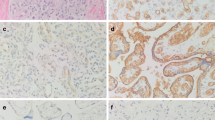Abstract
To examine the tumor-promoting effect of troglitazone (TRG), a novel thiazolidinedione insulin-sensitizing agent, on splenic hemangiosarcomas in rasH2 mice, histopathological and molecular analyses were performed in the spleen of female rasH2 mice fed a diet containing 6,000 or 0 ppm TRG for 16 weeks after 1,000 or 0 mg/kg urethane (UR) initiation. Histopathologically, splenic hemangiosarcomas were observed in the UR-alone and UR + TRG groups, but there was no significant difference in the incidence of splenic hemangiosarcomas between the UR-alone and UR+TRG groups. There were increasing tendencies in the number of positive cells for anti-PCNA antibody and gene expression in the UR + TRG group, but such a change was not statistically significant as compared to that in the UR-alone group. The gene expressions of VEGF, VEGFR1, VEGFC, VEGFR2 and Tie2 related to angiogenesis; c-fos related to MAPK cascade activation; and cyclin D1 related to cell cycle in the UR-alone and UR + TRG groups were significantly higher than those in the untreated control group. However, only the Tie2 gene in the UR + TRG group was significantly increased as compared to that in the UR-alone group. These results suggest that the vascular tumor-promoting activity of TRG in rasH2 mice is extremely low in the present experimental condition and a part of the gene related to angiogenesis probably contributes to the promotion of splenic hemangiosarcomas in rasH2 mice given TRG.



Similar content being viewed by others
References
Brown LF, Dezube BJ, Tognazzi K, Dvorak HF, Yancopoulos GD (2000) Expression of Tie 1, Tie 2, and angiopoietins 1, 2, and 4 in Kaposi’s sarcoma and cutaneous angiosarcoma. Am J Pathol 156:2179–2183
D’Arcy PF, Harron DWG (eds) (1998) Proceedings of the 4th international conference on harmonization. Queen’s University of Belfast, N. Ireland
Elangbam CS, Brodie TA, Brown HR, Nold JB, Raczniak TJ, Tyler RD, Lightfoot RM, Wall HG (2002) Vascular effects of Gl262570X (PPAR-gamma agonist) in the brown adipose tissue of Han Wistar rats: a review of 1-month, 13-week, 27-week and 2-year oral toxicity studies. Toxicol Pathol 30:420–426
Findley CM, Cudmore MJ, Ahmed A, Kontos CD (2007) VEGF induces Tie2 shedding via a phosphoinositide 3-Kinase/Akt-dependent pathway to modulate Tie2 signaling. Arterioscler Thromb Vasc Biol (Epub ahead of print)
Ghazzi MN, Perez JE, Antonucci TK, Driscoll JH, Huang SM, Faja BW, Whitcomb RW (1997) Cardiac and glycemic benefits of troglitazone treatment in NIDDM. The Troglitazone Study Group. Diabetes 46:433–439
Herman JR, Dethloff LA, McGuire EJ, Parker RF, Walsh KM, Gough AW, Masuda H, de la Iglesia FA (2002) Rodent carcinogenicity with the thiazolidinedione antidiabetic agent troglitazone. Toxicol Sci 68:226–236
Jeri El-Hage (2004) Preclinical and clinical safety assessments for PPAR agonists. DIA presentations, Washington DC. http://www.fda.gov/cder/present/DIA2004/default.htm
Jin M, Takahashi M, Moto M, Muguruma M, Ito K, Watanabe K, Kenmochi Y, Kono T, Hasumi K, Mitsumori K (2007) Carcinogenic susceptibility of rasH2 mice to troglitazone. Arch Toxicol 81(12):883–894
Keller H, Mahfoudi A, Dreyer C, Hihi AK, Medin J, Ozato K, Wahli W (1993) Peroxisome proliferators-activated receptors and lipid metabolism. Ann NY Acad Sci 684:157–173
Mitsumori K (2003) Possible mechanism on enhanced carcinogenesis of genotoxic carcinogens and unsolved mechanisms on lesser carcinogenic susceptibility to some carcinogens in rasH2 mice. J Toxicol Sci 28:371–383
Mitsumori K, Wakana S, Yamamoto S, Kodama Y, Yasuhara K, Nomura T, Hayashi Y, Maronpot RR (1997) Susceptibility of transgenic mice carrying human prototype c-Ha-ras gene in a short-term carcinogenicity study of vinyl carbamate and ras gene analyses of the induced tumors. Mol Carcinog 20:298–307
Mitsumori K, Koizumi H, Nomura T, Yamamoto S (1998) Pathological features of spontaneous and induced tumors in transgenic mice carrying a human prototype c-Ha-ras gene used for six-month carcinogenicity studies. Toxicol Pathol 26:520–531
Mori I, Yasuhara K, Hayashi SM, Nonoyama T, Nomura T, Mitsumori K (2000) Carcinogen dose-dependent variation in the transgene mutationspectrum in urethane-induced lung tumors in transgenic mice carrying the human prototype c-Ha-ras gene. Cancer Lett 153:199–209
Nesfield SR, Clarke CJ, Hoivik DJ, Miller RT, Allen JS, Selinger K, Santostefano MJ (2005) Evaluation of the carcinogenic potential of clofibrate in the rasH2 mouse. Int J Toxicol 24:301–311
Okamura M, Unami A, Matsumoto M, Oishi Y, Kashida Y, Mitsumori K (2006) Gene expression analysis of urethane-induced lung tumors in rasH2 mice. Toxicology 217:129–138
Ozaki M, Ozaki K, Watanabe T, Uwagawa S, Okuno Y, Shirai T (2005) Susceptibilities of p53 knockout and rasH2 transgenic mice to urethane-induced lung carcinogenesis are inherited from their original strains. Toxicol Pathol 33:267–271
Saltiel AR, Horikoshi H (1995) Thiazolidinediones are novel insulin-sensitizing agents. Curr Opin Endocrinol Diabetes 2:341–347
Saltiel AR, Olefsky JM (1996) Thiazolidinediones in the treatment of insulin resistance and type II diabetes. Diabetes 45:1661–1669
Storer RD, Freench JE, Haseman J, Hajian G, Legrand EK, Long GG, Mixson LA, Ochoa R, Sagartz JE, Soper KA (2001) p53± Hemizygous knockout mouse: overview of available data. Toxicol Pathol 29:30–50
Tontonoz P, Hu E, Spiegelman BM (1994) Stimulation of adipogenesis in fibroblasts by PPARγ2, a lipid-activated transcription factor. Cell 79:1147–1156
Toyosawa K, Okimoto K, Kobayashi I, Kijima K, Kikawa E, Kohchi M, Koujitani T, Tanaka K, Matsuoka N (2001) Di (2-ethylhexyl)phthalate induces hepatocellular adenoma in transgenic mice carrying a human prototype c-Ha-ras gene in a 26-week carcinogenicity study. Toxicol Pathol 29:458–466
Yamamoto S, Mitsumori K, Kodama Y, Matsunuma N, Manabe S, Okamiya H, Suzuki H, Fukuda T, Sakamaki Y, Sunaga M, Nomura G, Hioki K, Wakana S, Nomura T, Hayashi Y (1996) Rapid induction of more malignant tumors by various genotoxic carcinogens in transgenic mice harboring a human prototype c-Ha-ras gene than in control non-transgenic mice. Carcinogenesis 17:2455–2461
Acknowledgments
This work was supported in part by grants-in-aid from the Ministry of Health, Labor and Welfare and the Ministry of Education, Culture, Sports, Science and Technology of Japan.
Author information
Authors and Affiliations
Corresponding author
Rights and permissions
About this article
Cite this article
Jin, M., Matsumoto, S., Dewa, Y. et al. Extremely weak tumor-promoting effect of troglitazone on splenic hemangiosarcomas in rasH2 mice induced by urethane. Arch Toxicol 82, 771–777 (2008). https://doi.org/10.1007/s00204-008-0293-y
Received:
Accepted:
Published:
Issue Date:
DOI: https://doi.org/10.1007/s00204-008-0293-y




